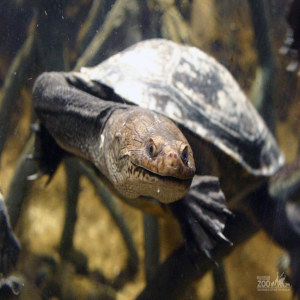 Chelodina Siebenrocki is commonly known a the dinner-plate turtle. It was named after the Austrian herpetologist Friedrich Siebenrock. They are the least known of the Australian turtles and one of the smallest members of the long-necked turtles of this genus.They are small to medium-sized, with oval shaped carapace growing to about 11 inches with its neck about half the length of the shell. Males are smaller than females. They are side-necked turtles, meaning they tuck their head partially around the side of their body when threatened instead of directly backwards. They are classified by the IUCN as near threatened. The international live animal trade had placed some pressure on this restricted-range species, especially in Indonesia.
Chelodina Siebenrocki is commonly known a the dinner-plate turtle. It was named after the Austrian herpetologist Friedrich Siebenrock. They are the least known of the Australian turtles and one of the smallest members of the long-necked turtles of this genus.They are small to medium-sized, with oval shaped carapace growing to about 11 inches with its neck about half the length of the shell. Males are smaller than females. They are side-necked turtles, meaning they tuck their head partially around the side of their body when threatened instead of directly backwards. They are classified by the IUCN as near threatened. The international live animal trade had placed some pressure on this restricted-range species, especially in Indonesia.
Location: The Lower RainForest
Share:
Range
Australia, New Guinea, Indonesian Rote Island, Papua New Guinea, and East Timor
Habitat
These turtles are semi-aquatic and spend time on land as well as in the water. They can be found in fresh water but also brackish water. They hide under and between rocks and logs where possible or bury themselves in the mud to act as an ambush predator to fish, amphibian, and invertebrate prey.
Conservation Status
Primary Threats
Gestation
Incubation is between 120-150 days and eggs hatch in the fall.
Litter
The nests are dug near water and they may lay up to three clutches of 8-24 eggs per year.
Behavior
They spend most of their time on the bottom of bodies of water. If it is too dry they estivate, meaning they go into dormancy, under fallen leaves on the forest floor or extended period of time until rains return.
Reproduction
Sexual dimorphism is quite evident as females have very short, stubby tails. Mating season is from September to October. These turtles are polygynandrous, meaning both males and females may have multiple mating partners during the season.
Wild Diet
They are carnivores and prey on a variety of aquatic species, including invertebrates, fish, terrestrial insects and plankton.
Zoo Diet

